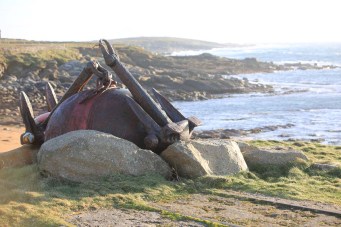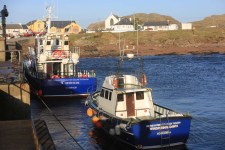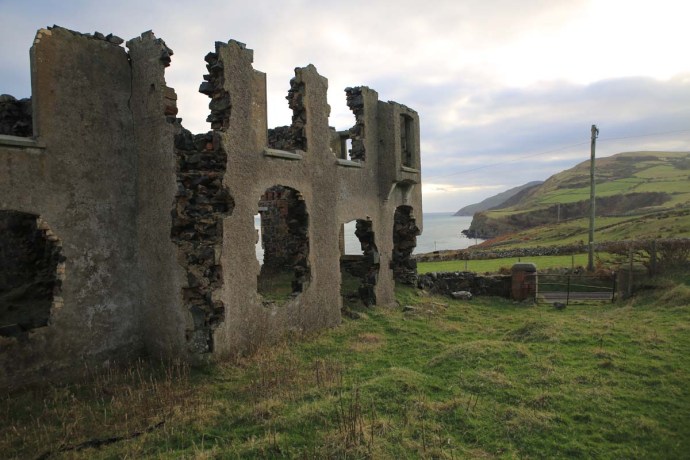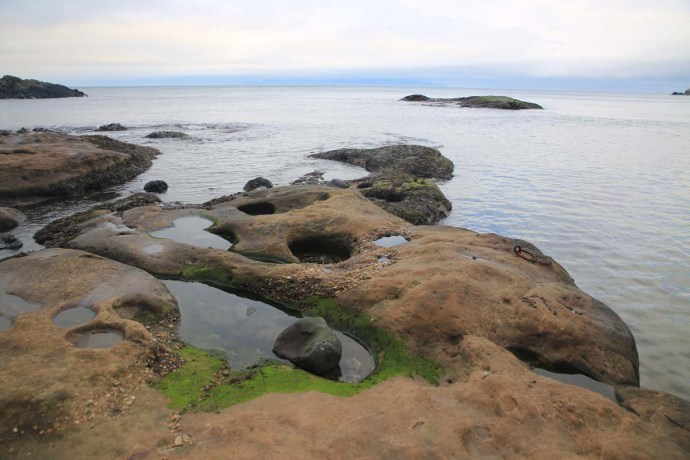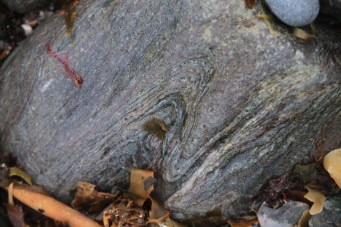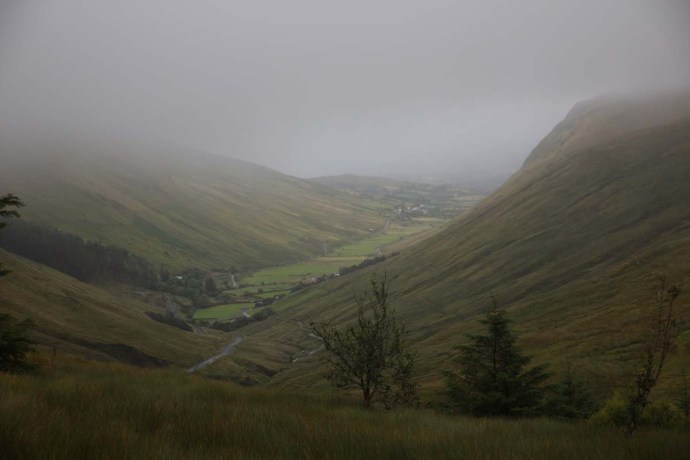
Magheroarty Beach, where the ferry departs to Tory Island
Tory Island. Those two words resonate loudly in my ears.
Back in the late 70s and early 80s when I played in Bush Bands in various remote parts of Australia, one of the favourite dances was the Waves of Tory. Well our version of it. With that lovely descriptive name reflecting the motion of the dancers with high potential for total chaos yet at the same time conjuring up romantic notions of a windswept wild wasteland in the North Atlantic.
As far away from the beautiful windswept wild wasteland of the Australian desert as could be.

Waves of Tory
Well now I have ridden the Waves of Tory and the imagined and fanciful has become real. It is wild and it was windy and those waves were something to behold but it was not a wasteland. It is surprisingly different to the other inhabited islands I have visited here such as Achill, the Aran Islands and Sherkin. It is stunningly beautiful.

Tory Island as seen from Magheroarty Beach
Tory Island, or just plain Tory, lies about 14km off the coast of Bunbeg in western Donegal. On the day I decided to go the ferry had already left from Bunbeg but I had time to drive to Magheroarty and catch the 11:30am.
I picked my day and was lucky. The forecast was spot on with sun predicted all day because I really wanted to photograph it in a clear light. But I forgot to check the ocean conditions and boy was there a mighty swell which made for a very rough trip.
We were warned to be back at the boat by 2pm, much earlier than scheduled, and if we didn’t get it we would be there for at least four days as storm conditions were expected to prevent the boat sailing for that time. This gave me about 1 ½ hours on the Island . I was disappointed but it is amazing how much I could see in that time, albeit fleetingly.
So back to the Waves Of Tory. We took the smaller of the boats, the romantically named Whispering Dawn, that usually do this run and it was filled with returning residents, with their shopping and all sorts of oddments that can only be got on the mainland. There was plenty of Guinness and whiskey and a massive birthday cake. Well that was what I guessed it was by its shape and the way they were carrying it, and a big bag of helium filled balloons which said 40th. So many things to plan for with life on a remote outpost. Goods were passed down the steps in a human chain, as they probably were since the boat started sailing there.

Everyone joins in to load the boat.
So the boat was packed finally, though a few late comers forced us to turn around after we had already headed out to sea. Wouldn’t happen with the Manly Ferry! When we finally got going it was rough. we were tossed around like one of those toy boats in a bathtub that Hollywood used to simulate a violent storm. Except this was real. Waves would swamp the deck as we listed first one way then the other. The Captain doing a marvellous job to turn the boat into the massive waves to avoid them hitting us broadside. Photography was pretty difficult with salt on the camera and the cameraman, but I got a few. Remarkably I didn’t get sea sick.

Ploughing through the waves on the way to Tory

All kinds of passengers
The Island loomed into view so slowly. The eastern end looked rugged and mountainous while the western seemed more topographically restrained. We pulled into the wharf with some relief and the passengers disappeared into their little slice of this Island world.

I knew Tory had a King. The current king is local artist and musician, Patsy Dan Mac Ruaíri. Elected by popular vote of the Islanders he has ruled since 1993. I was expecting to be met by him and his accordion. Every account of a visit to Tory talks about the King. Well not this one, because he just wasn’t there. Perhaps he was engaged on other official duties. I can only assume that it was of the gravest urgency to have kept him from meeting the boat and welcoming me.
The Island is fringed with granite boulders and slopes gently up from the seashore with a treeless plain that heads off to the horizon where there are a few rocky knolls.

There is a cluster of houses which is the main village and in the distance I could see other smaller clusters with only a few scattered houses in between. Much of the land seems barren and empty but you are drawn to explore.

The village is just a lovely higgledy piggledy jumble. Nothing is straight. The main road snakes around and the houses are built at different angles to each other. One suspects people here over time have just done what they pleased. Many vacant and ruined houses sit next door to beautifully painted and maintained cottages. In the centre of it all is the remains of a round tower, a bell tower from the 7th century and the only remaining part of a Monastry founded by St Columcille as a sort of getaway from the no doubt stressful life of being a saint. Prominent in the town is a generator and you are reminded of what it must be like to live here. Especially in winter. Indeed, in 1974 a massive storm cut the island off for two months. The response of the Government was to attempt to resettle the 130 residents on the mainland, but the islanders resisted and won the right to remain. A pyrrhic victory as there are virtually no facilities remaining.

The 6th Century bell tower is the only remains of the original monastery



Boats share the main street with houses
It’s maritime connection is never far away. Old boats are scattered through the village most unlikely to see their hull in water again, now part of the permanent streetscape.
They must be a special breed, the people who live here.
I loved the feel of the place. The hand painted signs, the unpretentiousness. The rawness reflecting a life that this particular day’s relatively benign weather temporary masked.
I had less than an hour left and I had no idea what the Island had to offer. I could see a light house in the distance but no time to go there. I should have done my homework I suppose but I went there on a whim. After walking through the town I kept seeing those knolls and ridges in the distance; so I headed across the bare paddocks.

A view towards the lighthouse


Wind assisted. When I got there the ground suddenly dropped away into preciptious cliffs. I had to work hard to avoid being blown off into the Atlantic. The view was stunning.


Land bridge in quartzite cliffs

Stunning, sublime, arresting, breathtaking. Substitute any other hyperbolic synonymy and you still won’t be able to describe it adequately. Some of the cliffs were of granite and some were of quartzite. And they were different to each other and to the cliffs of Clare. The granite cliffs were smoother, more rounded and with boulders perched precariously. Those of quartzite which formed the high cliffs of the northern end of the island were jagged and irregular with many offshore stacks and islands and even a land bridge. I continued to walk along the cliff edge and each corner would reveal another spectacular vista of rugged bays and pinnacles.



A quick look at the time and I had twenty minutes left to make it back to the boat. Got there no problem but disappointingly no sign of King Patsy to say goodbye to me and reluctantly just a handful of us embarked for the mainland.
But the trip back was not very pleasant. We had a bigger boat (Turasmara ) which seemed to handle the waves better but the sensible Islanders remained behind, ensconced in their homes in front of their warm fires while the few of us returning to ‘civilisation’ struggled with effects of the Rolling Waves. Some lost the battle. I fully expected to be a victim but somehow by standing outside in the open and clinging to a door handle with my legs braced against each wave and my eyes fixed on the receding Tory I rode it out
Forty five minutes later with heavy clouds moving in as if on cue, to announce the end of the journey, we were back somewhat unsteadily on land.
With my legs regaining their function I left the Kingdom of Tory behind and it was back to Bunbeg for a warm fire, a settling whiskey and a tune.
Two hours was definitely not enough. Next time I will stay and explore this remarkable place at my leisure. Definitely overnight.
Maybe I’ll even get a royal audience.




